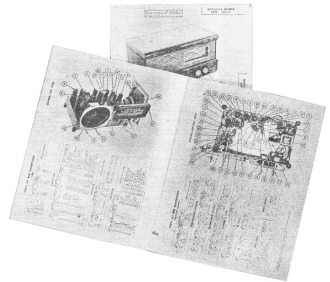|
August 1946 Radio-Craft
 [Table of Contents] [Table of Contents]
Wax nostalgic about and learn from the history of early electronics.
See articles from Radio-Craft,
published 1929 - 1953. All copyrights are hereby acknowledged.
|
I am embarrassed to admit that
I was surprised when I saw this announcement in the August 1946 issue of Radio-Craft
magazine for Sam's PhotoFacts entitled "A New Organization Attacks Circuit Information
Problems." Maybe it is because they eventually generated data packs for electronics
equipment prior to 1946, but I would have argued vehemently that Sam's was in business long
before 1946. The Sams Technical Publishing
website homepage states, "Since 1946 SAMS Technical Publishing manuals have been
the standard that repair technicians have insisted upon having to provide professional
repairs to their customers." I stand corrected.
Here are a few PhotoFact ads from vintage electronics magazine:
Sams PhotoFact 5/56,
Sams
PhotoFact 11/62,
Sams PhotoFact 4/48,
Sams PhotoFact
3/58, Sams PhotoFact May '48,
Sams PhotoFact
8/46,
TV
Colorgrams
Photofacts for Servicemen

Folders like this one will be issued on all sets made after January
1, 1946. Each will carry from four to a dozen pages of service information, depending
on the set described. These will include standard schematics, plus the photo-aids
here illustrated.
A New Organization Attacks Circuit Information Problems
Today's radio serviceman, in common with most of us, faces new problems. The
number of radio and phonograph manufacturers has skyrocketed. Where in prewar days
the serviceman could get by with service data on sets of about 35 manufacturers,
today he is (or soon will be) faced with the progeny of some 225 manufacturers.
It is estimated that these set makers will produce some 1000 models in 1946.
Competition for his business is another problem. Many veterans, who were non-professionals
before the war, were in radio work while in the armed forces. They are entering
the radio service field. There will be more radio servicemen then ever before.
FM sets, automatic record changers and, to a lesser extent, television receivers
will come in for repair with increasing frequency. Servicing will be more complex.
Even in prewar days the serviceman was troubled by inaccuracies in manufacturers'
service data. This condition will not improve for some time, with many new firms
staffed as they must be with some green hands in their service departments. In fact,
the situation may be worse than before the war.
In an effort to meet these problems a new method of supplying radio service data
has been developed by Howard Sams & Co., of Indianapolis. Known as the PhotoFact
service, it attacks the problems by supplying more complete and more accurate servicing
data on all sets made after January 1, 1946. In addition, methods of presentation
have been devised which make the material easier to use.
The plan is an improvement on a similar method successfully used by the Signal
Corps during the war. Armed with detailed information on the new sets, the serviceman
should be able to reduce the time spent on each job.
The Modus Operandi
Here's how the plan will operate on a typical new set. The Blank Radio Corp.
brings out their new model X. At the time it goes into production the PhotoFact
organization secures one of the sets and the manufacturer's schematic. The set is
analyzed by PhotoFact engineers and photographed in detail so that every part can
be identified clearly. The photos are then labeled with part identification numbers
keyed to a parts list. In addition, specifications of each part, including manufacturer's
part number, available alternate replacement types, together with installation notes,
are compiled. The manufacturer's schematic is checked against the set and redrawn
and corrected if necessary. At the same time, complete voltage and resistance measurements
are made. Alignment procedure is checked; location of all trimmers is labeled on
the parts location photos in numbered sequence corresponding to actual alignment
sequence. The numbers are keyed to written alignment instructions. Finally the set
is given a performance check and overall and stage gains measured. All this data
is then compiled into a PhotoFact folder on the Blank Model X. The completed folder
will contain from 4 to 12 pages, depending on the size of the set. Several pages
of a typical folder are shown. Most set manufacturers are cooperating in the plan,
and it is hoped that it will be possible to issue a PhotoFact folder on each new
set within 90 days of the date it goes into production (by the time the new set
guarantee has expired on the first sets sold). This time factor will be of great
value to the serviceman. No longer will he be asked to service a new set for which
he has no data.
Several Other Services
Another time saver is the information furnished on alternate replacement parts
to use if manufacturer's exact replacements are not available. By listing the catalog
numbers of suitable parts made by several part manufacturers, the serviceman is
saved the time and bother of searching through catalogs for a part that may fit.
Subscribers to the service will receive the folders on new sets in groups covering
30 to 50 sets at a time. A loose leaf binder will be available to subscribers for
filing the folders.
In addition to the PhotoFact folders, the organization has established an advisory
service for subscribing service men. The advisory service, headed by 30 specialists
in radio, radar, and radio servicing, will aid in solving subscribers' problems
in servicing techniques, shop operation, promotion and all other phases of successful
business operation.
Posted October 10, 2022
|










